The designs for a contentious six-story development of affordable apartments to rise on the half-block parking lot parcel at 88 Broadway, at the base of Telegraph Hill, have been drafted by Leddy Maytum Stacy Architects.
Identified by the Port of San Francisco as “the greatest affordable housing development opportunity among the Port’s seawall lots in the northeastern waterfront,” but having faced neighborhood pushback over just how affordable the development should be, the Seawall Lot 322-1 site was awarded to The John Stewart Company and Bridge Housing with plans for 182 units – 130 of which are to be made available to families earning 50%-120% of the Area Median Income (AMI) and 52 units for seniors earning 40%-70% of the AMI – to rise over 11,400 square feet of retail/commercial space, including a 55-slot mixed-income childcare center to be operated by the YMCA of San Francisco.
A subsidy will enable 20% of the development (37 apartments) to be set aside for formerly homeless households with on-site supportive services provided by Lutheran Social Services.
Publicly accessible mid-block passages would connect Broadway to Vallejo and Front to Davis.
And the development team is investigating the feasibility of building the development’s 189 parking spaces underground.
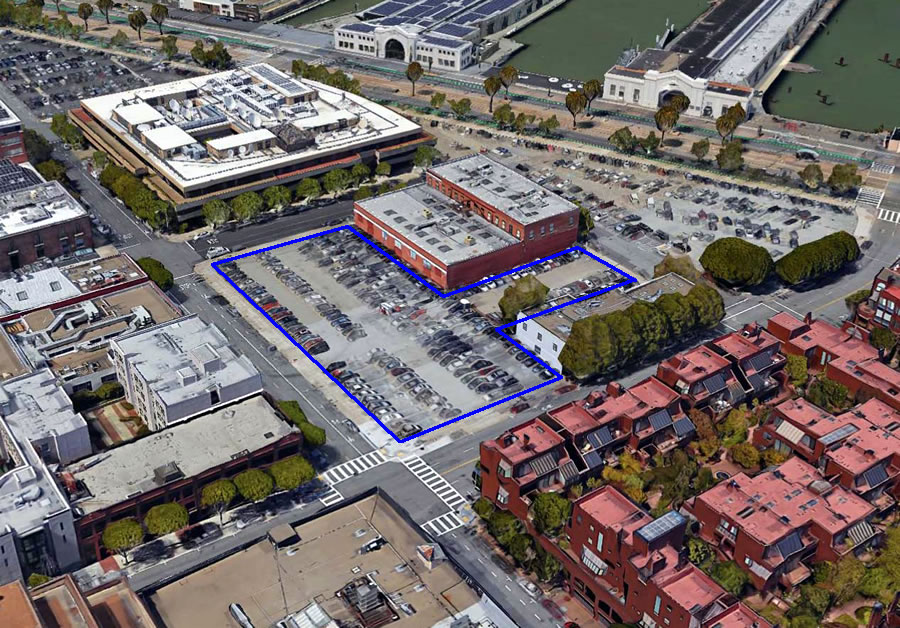
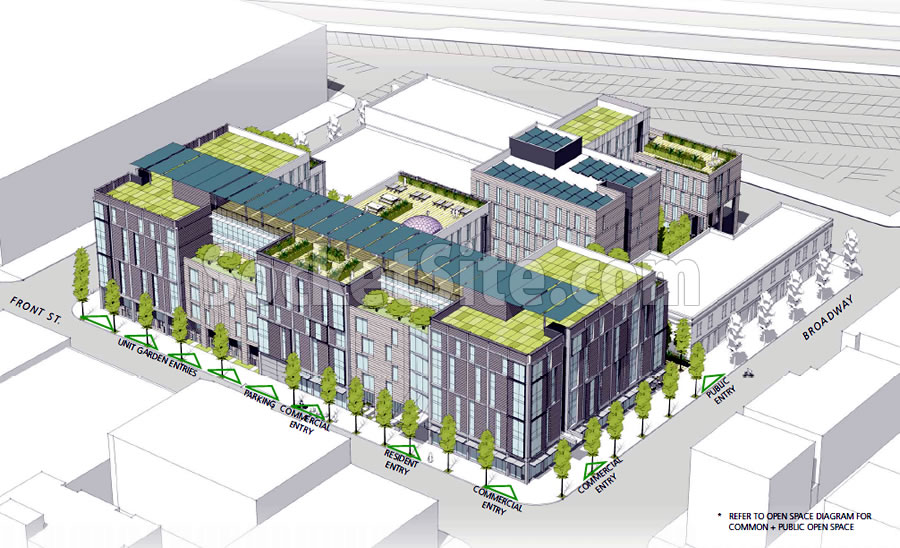
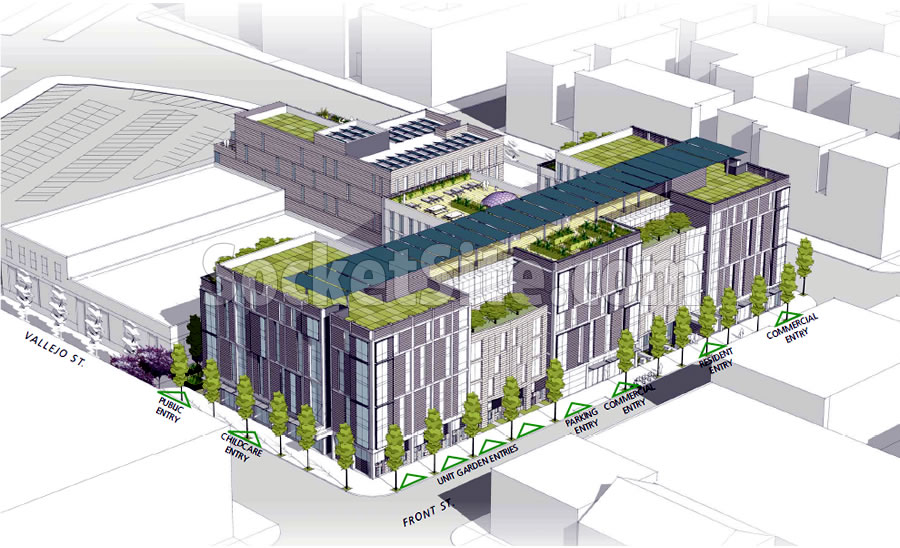
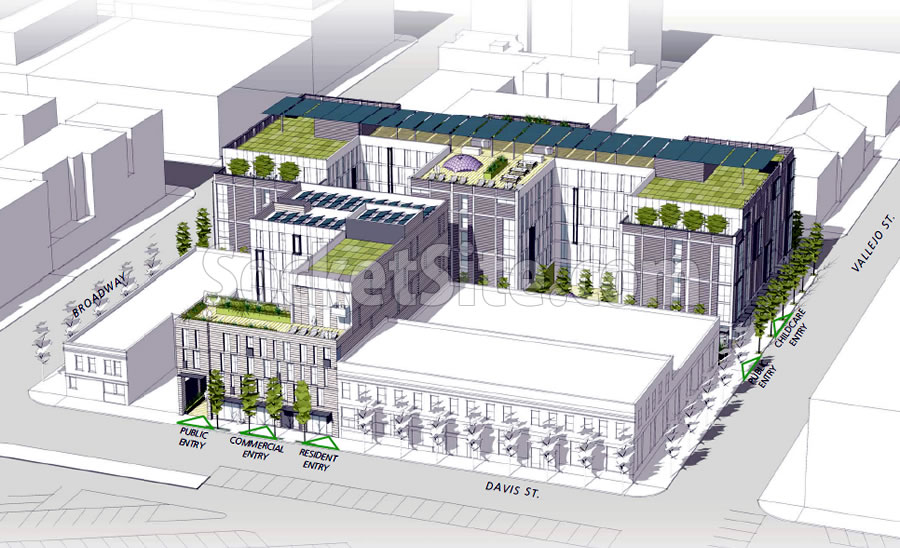
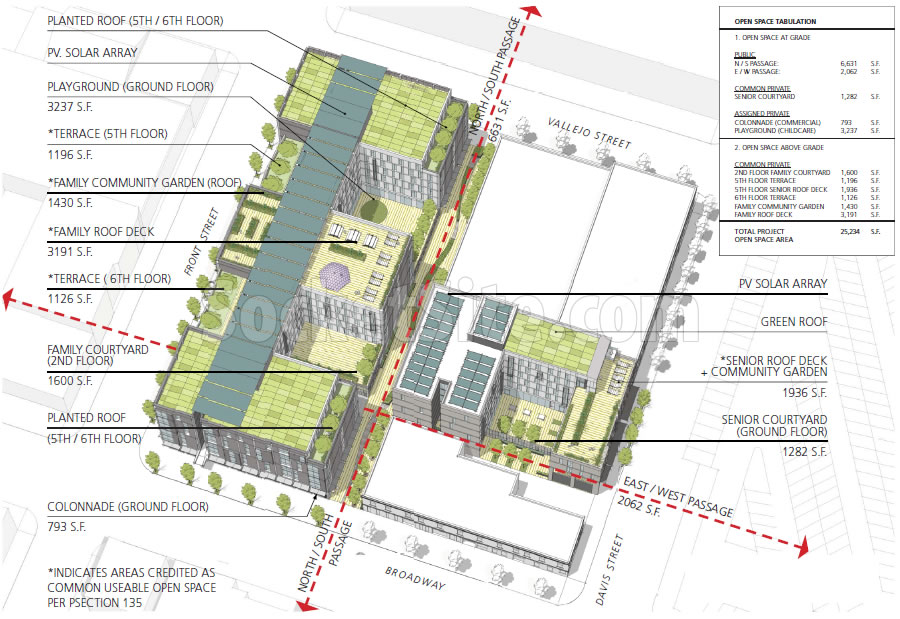
Or you could develop multi-million dollar condos on the site and cross subsidize many many more affordable units further inland than a block from the waterfront , but that would be too sensible. But as long as Telegraph Hill Dwellers is against this, I’ll be for it in any case. 😉
“saving money” by building all affordable housing in one, less expensive neighborhood has failed multiple times for multiple reasons throughout US history.
I agree, but that’s not what curmudgeon was suggesting.
I think it’s called “ghettoization.”
I agree with your first sentence.
It sounds sensible, but in reality it doesn’t work.
Only an idiot makes hamburger out of filet mignon.
what exactly is the hamburger in this case? affordable housing? low-income folks? does that make rich people filet mignons? pretty silly analogy.
yes, we need to grind rich people into hamburger meat, with a side of pressed architect aioli.
Affordable housing is hamburger. The land is prime and deserves product that will generate the most revenue. This might not be politically correct for all the spectators here with no skin in the game but it is the truth. In lieu fees could produce 3x affordable units somewhere else. Nevertheless, the progressives that pander to the left continue to mismanage resources to get votes. Where have these policies gotten SF? #1 Least Affordable city with #1 Most Entitled a Tenants.
Yeah, we tried that already and it got us Proposition B, courtesy of Telegraph Hill Dwellers. Remember 8 Washington?
There is value in mixed-income neighborhoods rather than developing a city in which all poor people live in a ghetto.
Exactly right. I live a few blocks away, I’m all for this.
idk, that really is PRIME prime real estate, was there literally no other place they could do this? richmond or ingelside maybe? balboa park? I’m all for forcing snobby rich people to live next to [lower income] people but…. just seems wasted.
it has nothing to do with political correctness (when are people gonna stop drawing that binary?) … it has to do with the city we want to create. do we want a san francisco where all the low-income folks live in one neighborhood because it was most efficient to build there? do we want to defend a policy of manufactured ghettos? and then when that neighborhood gets cool (see west oakland) those families are again displaced, extending the problem of affordability into the future.
your suggestion has no solution. slightly more money from selling the property will not solve the problem.
Except that no one is suggesting we put all the low-income residents in one neighborhood.
Visit the projects at Baker & Sutter and tell me those people are making an effort to integrate into their surrounding community. What a joke! The whole place is a blight on the community and none of the project residents take any pride in their building because it was given to them by Uncle Sam. it’s a lose-lose.
Where? Where in SF are we going to be able to build these cost effective units?
Anywhere but the most expensive real estate? How about spread across all neighborhoods that are not in the top 10% in land cost?
Could you be more specific? What you’ve offered is not an answer.
ingelside, richmond, balboa park, oceanview, stonestown, daly city…
So you’re going to put 182 units in single family districts? If I divide the 182 units by the 5 neighborhoods you’ve listed in SF, then you need to find a site for and entitle a 36 unit project in one.
But according to @hitman, we can build 3x the housing, so you actually need to find a site and develop 108 units in each of those neighborhoods. I am sure the neighbors will greet you with open arms, just a small 108 unit building next to their single family home.
Once you’ve got these 5 entitled, I say then release the site permit on that luxury market rate building you’re proposed on the waterfront.
those are hardly “single family neighborhoods”
I lived over there and it’s not as dense as it should be but there’s plenty of apartments, it’s not like it’s suburbia. Also there’s the city’s largest parking lot right next to ccsf as well as spaces down by SFSU. Balboa park has some gaps as well.
That’s what they are primarily zoned as, except some of the busier corridors, but they’re still typically 40′ height limit. At 4 floors of residential, you need a pretty big site to fit 108 units, look at the size of this site at 6 stories.
I think you’re right that these neighborhoods should be denser; it would make a more affordable and nicer city.
I just don’t believe in defering affordable housing under some promise of more later. I think it doesn’t happen the way commenter here suggest.
also affordable housing projects tend to be better built and offer more public amenities to the community sooooo this is like a kobe burger or something.
That’s hilarious. Come see this place 5 years after opening and tell me you’d like to live there.
Sad.
I assume you mean taking some of the most expensive, desirable land close to the FiDi and using it for subsidized housing. And I completely agree. This could generate millions for the City in initial sales and future tax revenue. The real estate tax from this project could pay for subsidized housing and social services. This represents the most egregious example of well-intentioned, but wrong-headed urban planning.
your utilitarian suggestion — of selling the expensive land to build more housing in a less-desirable neighborhood — forces low-income families in to under-invested neighborhoods. it magnifies the struggles these populations already face. it creates “ghettos” in our cities that become expensive to “clean up”. it allows rich people to avoid the realities of our economy.
multiple examples of your suggestion failing throughout US history. case study #1 = pruitt-igoe.
Wow. Pruitt-Igoe was a massive development of dehumanized, bleak towers. Hardly relevant to this discussion. I think you will agree this is some of the most expensive real estate in San Francisco. It’s basically made up of upper-middle class residents. The option is not placement in a ghetto, but in a middle class area with lower real estate values. Sunset, Richmond; hardly squalid areas. But the real estate tax from the waterfront location could subsidize another development. That would reduce the costs to the City – and free up other funds. This isn’t about social engineering; it’s about maximizing the value of the land to help everyone.
” It allows rich people to avoid the realities of our economy.”
No, it allows poor people to get what they want with out putting any real effort into getting it….
pruitt igoe and cabrini green were massive successes until the middle income residents moved out and the remaining residents didn’t bring in enough money to support the upkeep of the buildings so it got worse and worse and more and more moved out until it was essentially abandoned, pipes bursting and freezing, trash everywhere etc. it was all because of a lack of maintenance… made worse by a lack of police presence, they were also massive projects ON TOP of that they also forced men out of the projects, so you divided up familys and put all the child rearing onto the women while the men were essentially homeless… how is that a recipe for success?
Not bad. Looks like it could be a nicely handsome building. Now if only the Telegraph Hill Dwellers would get hit by a meteor at their next meeting…
BTW, “we” could build housing for San Franciscans even MORE cheaply if we sold all City land to private developers and then built low income housing in Fresno. Which just shows how ridiculous the objections to this project have been. Save for those for whom what they really want is all the poor people in SF to move to Fresno. Because, you know, if you can’t afford to live here, you don’t deserve to be here.
Thankfully, the majority of voters in SF aren’t so anti-American and unpatriotic.
If you’re responding to my original comment that’s not in any way what I said. My comment is really quite micro.
Its not actually. Your position is as exclusionary as the extreme example I cited. I know the Ayn Rand fans tend to congregate on these kinds of blogs, but globally, you are in the minority. Which is why this project is getting built precisely where it should be. In a safe, high income neighborhood that has access to amenities and opportunity.
The alternative is the ghettoization of the poor in San Francisco.
Oh Jeez Pleeze, the last time I was an Ayn Rand fan was when I was 13 years old, and the phase lasted only about six months. STOP assuming I’m someone I’m not.
If you can’t afford to be here, you can’t afford to be here. Deserve has nothing to do with anything.
You could argue that society benefits if people live close to where they work by decreasing transportation costs, for example. Speaking about the social benefits of mixed income communities is an actual argument. Speaking about where people deserve to live makes me ask why I don’t deserve a nicer car or a nicer apartment.
considering how disruptive and asinine the TH dwellers have been, especially by opposing the formerly beautiful 8 Washington because it was too luxury, I hope this building is filled only with the formally homeless or as a halfway house for felons, and i hope they use AHBP to bump the height even more.
Nice. This is good answer to NIMBY hypocrites. Have George Lucas made any progress in his affordable housing development in his ranch?
This will probably cause Aaron Peskin to ban all affordable housing.
It’s not clear to me the rationale for the midblock passages. This isn’t a superblock or otherwise an obstruction to the regular grid. If they were going to line them with retail, maybe…
I guess the gap also serve as a light well. Someday the corner buildings may be redeveloped and they will lose their east facing sea view.
I luv the gaps. Whats more ‘pedestrian-friendly’ that places for peds to walk. Too much of modern urban planning places things on a massive scale. I dislike that so many SF alleys have been given over to the likes of Westfield Ctr etc.
i hate superblocks… that’s all we have in indianapolis :/
If they are kept clean and policed.
A building like this should be legal on every parcel in San Francisco and Oakland. If it’s good enough for Telegraph Hill, …
Should increase the density and have it all BM rate, for families.
this project is 100% below market rate.
For families.
this land is under CA State legislation that requires it be used for affordable housing as a condition of removing it from public trust of tidelands and the Burton Act. SF has to get permission from state agencies to use it for anything else, as well as spend the money from it to buy other land or put the money into a state fund (see SEC5. of the legislation at namelink).
Ah, I forgot about this. Thanks for the explanation, Jake.
Seems like a lot of parking for an affordable housing development. Could cut back on the expense of the project by reducing the amount of parking.
This bus rider agrees.
I don’t understand why they’d have any parking especially where this is ESPECIALLY in SF… i mean why would people living in this area and in that income level need a car?
You obviously haven’t seen the Escalades and M3s in the Western Addition projects. These people have plenty of money, they’re just gaming the system.
like how homeless people have ipads?
Luxury subsidized housing distributed to a special anointed class. How incredibly unfair. Everyone who does not get this limited edition perk should sue for their fair share !
Who is the special anointed class? Families earning 50%-120% of the Area Median Income (i.e. low- to mid-income families) and seniors earning 40%-70% of the AMI (i.e. low income seniors)? “Anointed” in what way? Anyone who earns more, or less, than that should sue? Sue whom? For what? Go ahead – file a lawsuit if you think you have a serious claim and put your outrage to some use.
I believe Sara’s point was that in constructing a small amount of housing this expensive when you could construct housing much more efficiently elsewhere (say, a building twice as tall on a cheaper piece of real estate in the Richmond), you’re creating a lottery where only a tiny lucky fraction (‘anointed’) wins the lottery (often a literal lottery) and the rest are screwed and get NOTHING. It’s not a bad point, honestly.
But as many people here have already pointed out, this vast supply of housing constructed elsewhere is pretty much mythical. Given State law, given a decent design, all of these claims are…pointless.
Everyone who does not have kids should sue to get back their tax money that goes to schools. Or renters should sue to void all the tax breaks that homeowners get and, even more so, that owners of rental property get. I am a homeowner and an owner of rental property so I’m in an anointed class too.
I don’t begrudge BMR housing. I think the minimum requirement for BMR units in market rate housing projects should be increased.
That said, only a very few in need will get a BMR unit. I personally think those wanting to own real estate who’s only hope is to win the BMR lottery should consider purchasing a rental home in a good, less expensive market. As long as it cash flows. Going this alternate route gives one all the equity gain to come and more tax advantages than a BMR unit would offer..
All property tax increases are the will of the voters. A developer of a property is not in this business of charity. They have to make a profit also. BMR units are required under the current policies in the City. Oh how people forget the GFC and nothing being built from 2008-2011.
Right! why middle classes don’t deserve BMR housing since they pay a lots of taxes!
Few “middle class people” are buying homes in SF at current market prices.
Many of these affordable units are targeted at 80-120% income levels, which to me seems pretty “middle class” to me. Or are you one of those households earning 500K per year who deludes yourself into believing you are lower middle class?
No matter what level of middle class I am. I’m paying heavy taxes, but don’t have any benefit.
but people who pay less, and get a lot. still not feeling satisfied.
Has it failed as spectacularly as San Francisco’s current strategy of making its streets open air refugee camps for America’s dropouts while we find them housing in the most expensive city in the nation near jobs most dont have the motivation, skills or ability to fill while the poor aholes paying their way get stuck in longer and longer soul sucking commutes on our failing public transit system?
I know another couple with a BMR in SF they use as a weekend pit stop as they own a house in Napa ! How nice they have sucked their luxury off the backs of others !!!
I used to feel bad for homeless people but after living in redding and SF…. it totally changed my opinion for the worse. I think most of those homeless people (any without families) are just lazy drug addicts. still feel a little bad for them but I place most of the fault with them.
Or the morbidly obese couple who were eking by in rural Vermont who…HEY! moved across country to the most expensive city in the US with no jobs, no skills, and self-inflicted medical issues.
I have decided to become a heroin addict so I can get a free apartment!
who?
I have a friend living in 100 van ness in a BMR unit. She works her tail off, pays her taxes, a fine person. I think this project should be 100% for families.
I know someone living in a BMR unit and they can afford a vacation house in South America ! How nice their luxury vacation house has been subsidized by others…..
I know so many people who have so much time on their hands they spend it whining about others who might get something they think they deserve more.
What a terrible (proposed) waste of prime property.
Really…. “a waste”…. want to reconsider your choice of words?
it’s a waste in that it wont’ be maximizing it’s economic potential…. which is true.
Just where is it documented that the THD is still actively opposing this project as proposed?
I bet 50 yrs from now this will become like Midtown Apts or those on McAllilster & Buchanan/Octavia. Social Engineering – whats not to luv?
Perhaps like Geneva Towers these too may be imploded.
I’m confused why they couldn’t make this look like 2000 Bryant? If there were ever a development fitting of a brick facade that pays respect to the adjacent neighbors, this would be it. Oh well, it’ll be a crappy “modern” design with randomly spaced slits for windows and colored panels haphazardly plastered across the facade.
well brick facades cost alot more than hardie… for one thing.
I wouldn’t live there no matter how much money I had. Where do you shop for food? Imagine the traffic and congestion. Don’t plan on having a car, that’s for certain.
well it’s SF and theyre low income…. so they probably don’t have a car. priorities are “safe” neighborhood…
this is within waking distance of a Safeway, the Ferry Building, and Chinatown…but “Where do you shop for food?” well, where do you?
But But But…there is no Super WalMart with a massive free parking lot! Are you some kind of COMMUNIST?
I don’t think anyone living in a BMR unit would be doing much food shopping at the Ferry Building.
Nobody acknowledges this property is in the Northeast Waterfront Historic District . . . thus much of the criticism is about its bulk and inappropriate design, not paying attention to the required design guidelines from the Secretary of Interior. Another factor for criticism is the proposed Zinzani threatre and hotel on the corner of Broadway and Embarcadero, also in the NE Waterfront Historic District. Much to much bulk for the 2 sites in the SE corner of the District.
They buried the biggest piece of the story: 189 parking spaces underground! Why do they need parking? So they can drive to jobs in Marin and Silicon Valley? Isn’t this supposed to help the working class withing SF?
Though hesitant to weigh in here, my apartment investment experience informs a somewhat different perspective. In my view, addressing affordable housing stock as currently pursued is failing. Set aside units in new developments is a painfully slow process, adding few true affordable units to the inventory. Likewise projects such as the one discussed here create ‘affordable enclaves’ rather than successfully integrating all in broadly diverse communities.
After many years as an investor and some as a developer, I believe the dire need for affordable housing might best be addressed by taking advantage of an existing resource….existing, older apartment stock, much of which is low density and functionally challenged or no longer competitive. Thus, old, low density product encumbers potentially higher density sites. I might suggest providing existing owners with significant density bonuses, expedited approval and EIR…in exchange for the corresponding requirement that any redevelopment of an existing apartment site will provide for significantly higher density and will include 30% affordable units. In so doing, owners might elect to redevelop, thus providing additional housing stock. Alternatively, they might simply elect to sell to developers who would then capitalize on the higher density opportunity.
I fully recognize there are multiple challenges associated with this approach. However, developers respond to opportunity and incentives….as my once longtime mentor would say ‘builders build’. Simply legislating enclave affordable housing or requiring set aside units from new developments does not provide sufficient inventory. Likewise, legislating rent control does not address the fundamental challenge…we have demand and have not developed policies, incentives, etc to build appropriately priced supply. The net result is that the highest rents in the country exist in the most legislated, mandated, rent controlled markets…SF, NYC, Santa Monica, Berkeley…and the list goes on.
Perhaps a different approach is in order? More carrots and less sticks…coupled with less polarizing commentary might be another way to go.
Respectfully.
Don’t see the argument for building affordable housing in a “cheaper” neighborhood. Subcontractors don’t lower their prices because they’re building in Ingleside/Balboa versus any other neighborhood. SF drops so many regulations on affordable housing development (union labor requirements) that make it expensive no matter where you’re building in the city. And low-income people like to eat and shop too, they can support local businesses now that they won’t be spending over half of their income on rent.
Wonderful. Let’s devote prime real estate to those who refuse to advance their lives and have a proven track record of bringing crime everywhere they go. I take nobody on the BOS lives or works in this area.
Your repeated (endlessly…we understand you think everyone below the top 1% is unworthy of your illustreous self, but geez) bitter comments aside, the implication that anyone who is not Upper End SF-level wealthy is some kind of leech is worthy of a Romney or a Trump. Which belies your definition of yourself as a superior human being.
You infer quite a lot. I grew up poor and made my money without subsidies. Anyone who spends more than one year on welfare is, indeed, a parasite unless they have an authentic disability. 99% of the people on welfare are there by choice. My girlfriend is a case worker in the TL and I’ll bet dollars to donuts that I have a much more thorough understanding of and prolonged exposure to these people than you ever will. But, please generalize and make inaccurate guesses about my politics. Your black & white thinking is hilarious!
The underground parking is not in the plans as indicated in several recent public discussions, only less than 20 spaces for a ZIP Car installation on street level near the NW corner.
Build it. Build it now. Maybe Art Agnos will perform the ribbon cutting?.
UPDATE: Hill Dwellers Seek a “Right-Sizing” of Affordable Development Below
As a resident/homeowner near Broadway, I wholeheartedly support building this affordable housing. The John Stewart Company and Bridge Housing are both fantastic companies, and Chairman John Stewart himself is a Telegraph Hill resident.
I hope all the issues and concerns with other Telegraph hill dwellers are worked out, so this much needed affordable housing can be built.
Aaron Peskin, you know my own story, and thanks to you, I have a home in Chinatown/North Beach – please support this project too!
I was homeless when Aaron Peskin supported saving the apartment building I now live in, and creating a limited equity housing coop.
I worked my ass off earning minimum wage, but managed to save enough money to buy into my coop, and along the way, I was encouraged and inspired to find a career in affordable housing that pays a living wage. Low income folks are not losers.
Similarly, Mayor Edwin Lee grew up in Section 8 public housing, so did Board of Supervisors President London Breed, and look at how both of them have succeeded.
I am proud of our communities, the opportunity to provide hard working, low income families homes, and for their children to succeed in wonderful ways. Please give this housing proposal a chance – John Stewart is a great developer, quality buildings, very well managed, very professional.
UPDATE: Affordable Development Appealed by Neighbor in Telegraph Hill